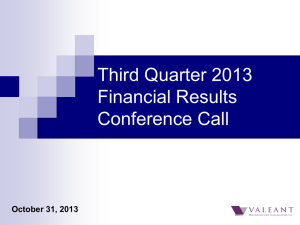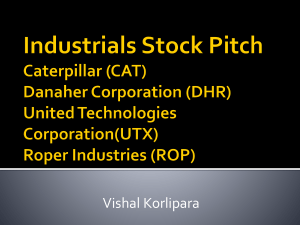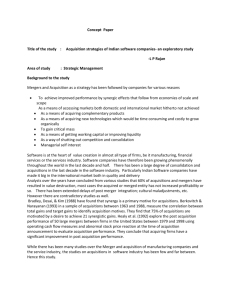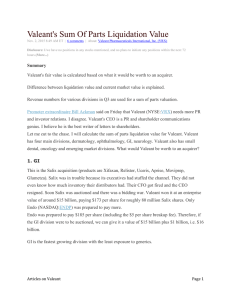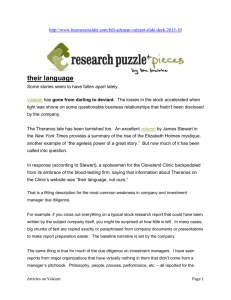Ira-Sohn-2015-Presentation - Pershing Square Holdings, Ltd.
advertisement
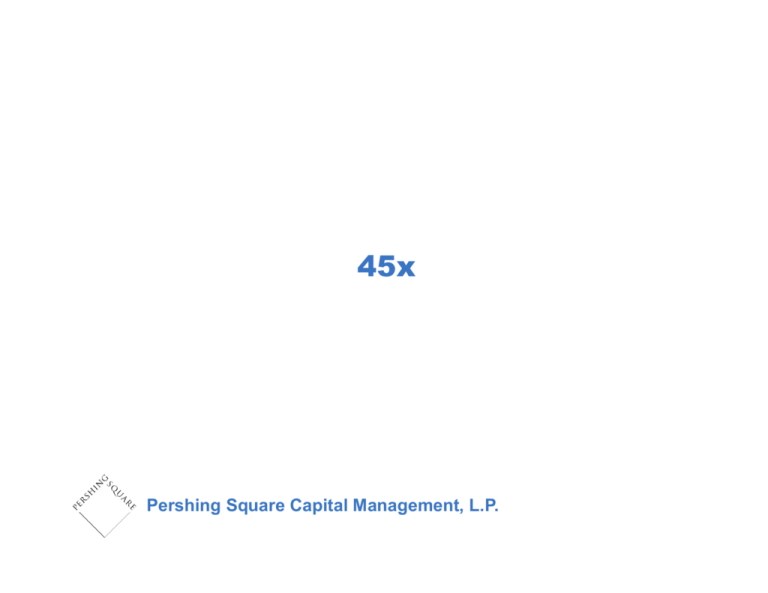
45x Pershing Square Capital Management, L.P. Disclaimer The analyses and conclusions of Pershing Square Capital Management, L.P. ("Pershing Square") contained in this presentation are based on publicly available information. Pershing Square recognizes that there may be nonpublic information in the possession of the companies discussed in this presentation that could lead these companies and others to disagree with Pershing Square’s analyses, conclusions and opinions. This presentation and the information contained herein is not investment advice or a recommendation or solicitation to buy or sell any securities. All investments involve risk, including the loss of principal. The analyses provided may include certain forward-looking statements, estimates and projections prepared with respect to, among other things, the historical and anticipated operating performance of the companies discussed in this presentation, access to capital markets, market conditions and the values of assets and liabilities. Such statements, estimates, and projections reflect various assumptions by Pershing Square concerning anticipated results that are inherently subject to significant economic, competitive, and other uncertainties and contingencies and have been included solely for illustrative purposes. No representations, express or implied, are made as to the accuracy or completeness of such statements, estimates or projections or with respect to any other materials herein and Pershing Square disclaims any liability with respect thereto. Actual results may vary materially from the estimates and projected results contained herein. The information contained in this presentation may not contain all of the information required in order to evaluate the value of the companies discussed in this presentation. The opinions, analyses, conclusions and proposals presented herein represent the views of Pershing Square and not those of any third party. Funds managed by Pershing Square and its affiliates are invested in securities of some of the companies mentioned in this presentation. Pershing Square manages funds that are in the business of trading – buying and selling – securities and financial instruments. It is possible that there will be developments in the future that cause Pershing Square to change its position regarding these companies. Pershing Square may buy, sell, cover or otherwise change the form of its investment in these companies for any or no reason. Pershing Square hereby disclaims any duty to provide any updates or changes to the analyses contained here including, without limitation, the manner or type of any Pershing Square investment. 2 Jarden Corporation: ~45x Return in 14 Years Since Martin Franklin joined Jarden in 2001, the company has achieved success as a well-managed consolidator of consumer products assets, generating a ~45x total shareholder return to-date Indexed total shareholder return of Jarden from 6/25/2001 to 5/1/2015 8/29/14: Acquired Rexair for $349mm Indexed total shareholder return 5,000% 4,500% 3/27/02: Acquired Tilia for $160mm 4,000% 3,500% 3,000% 2,500% 2,000% 1,500% 2/7/03: Acquired Diamond Brands for $110mm 1/24/05: Acquired American Household for $845mm 9/2/03: Acquired Leigh for $155mm 7/18/05: Acquired Holmes Group for $625mm 9/5/06: Acquired Pine Mountain for $150mm 4,518% 4/1/10: Acquired MAPA for $500mm 4/6/07: Acquired Pure Fishing for $400mm 7/9/07: Acquired K2 for $1.2bn 10/3/13: Acquired Yankee Candle for $1.8bn 1,000% 500% 6/28/04: Acquired U.S. Playing Card for $240mm 0% Jun-01 Jun-02 Jun-03 Jun-04 Jun-05 Jun-06 Jun-07 Jun-08 Jun-09 Jun-10 Jun-11 Jun-12 Jun-13 Jun-14 Jarden Corp. S&P 500 362% 228% S&P Mid Cap 400 Note: Total shareholder returns are calculated per Bloomberg from June 25, 2001 to May 1, 2015 with all starting values indexed to 100%. 3 3 Investors Have Consistently Underestimated Jarden’s Earnings Potential In June 2001, investors could have purchased Jarden’s shares at ~0.4x 2016 Consensus EPS(1) Jarden’s Historical Share Price as a Multiple of 2016E Earnings (6/25/2001 to 5/1/2015) 16x 14x P/E Multiple 12x 10x 8x 6x 4x 2x 0x 2001 2002 2003 2004 2005 2006 2007 2008 2009 2010 2011 2012 2013 2014 P/E Multiple of 2016E Earnings Source: Bloomberg. Stock price adjusted to assume reinvestment of dividends. (1) Based on Bloomberg Consensus 2016 EPS of $3.149 as of May 1, 2015. 4 Platform Specialty Products (NYSE: PAH) Martin Franklin, Chairman of Jarden, and private investor Nicolas Berggruen co-founded PAH in early 2013 In May 2013, PAH raised approximately $900mm(1) in a public offering at $10 per share In October 2013, PAH announced the acquisition of MacDermid Inc., a specialty chemical company, for $1.8bn PAH has subsequently acquired three businesses in the agricultural chemicals industry for approximately $5 billion Today, PAH trades at $27.40 per share, a ~175% increase from its public offering price just two years ago (1) http://ir.platformspecialtyproducts.com/faq.cfm 5 Platform Specialty: ~175% Return in Two Years PAH Share Price from 5/16/2013 to 5/1/2015 $35 10/10/13: Announced acquisition of MacDermid for $1.8bn TEV $30 PAH Share Price $25 $20 $27.40 5/16/2013: Began trading near cash NAV $15 4/17/14: Announced acquisition of Chemtura AgroSolutions for $1.0bn TEV $10 $5 $0 5/16/2013 8/16/2013 11/16/2013 2/16/2014 5/16/2014 8/6/14: Announced acquisition of Agriphar SA for €300m TEV 8/16/2014 11/16/2014 10/20/14: Announced acquisition of Arysta LifeScience for $3.5bn TEV 2/16/2015 Source: Bloomberg. 6 Nomad Holdings Limited (NOMHF) (“Nomad”) Martin Franklin and Noam Gottesman, co-founder of GLG Partners, co-founded Nomad in early 2014 In April 2014, Nomad raised $500mm(1) in a public offering and began trading at a valuation approximating its cash per share In April 2015, Nomad announced the acquisition of Iglo Foods Holdings, the largest frozen foods business in Europe, for approximately €2.6 billion from private equity owner Permira Nomad is financing its acquisition of Iglo with cash on hand from its IPO, debt financing, and a $750mm private placement of equity Nomad has called Iglo its “anchor investment”(2), and intends to use this asset as a base for future food industry acquisitions (1) (2) Includes $485mm in ordinary shares (with matching warrants) and $15mm in founder preferred shares. Source: http://www.reuters.com/article/2015/04/20/us-iglo-m-a-nomad-foods-idUSKBN0NB1C520150420. 7 Nomad Holdings: ~80% Return Since IPO Nomad shares have increased by ~80% in just over a year, driven by the Iglo acquisition announcement Nomad share price from 4/9/2014 to 4/27/2015(1) $20 Nomad Share Price $15 4/9/2014: Began trading near cash NAV 4/20/15: Announces acquisition of Iglo Foods Holdings for €2.6bn TEV $18 $10 $5 $0 Source: Bloomberg Note: Presented as Nomad Holdings (LSE) through 4/20/15 and NOMHF US, a grey market tracking stock, from 4/20/15 through 5/1/15 following the LSE de-listing. (1) Trading in Nomad shares was halted subsequent to 4/27/2015. 8 Nomad Holdings: Why Has the Stock Gone Up So Much? Nomad’s share price has increased dramatically since the Iglo Foods acquisition was announced What are the possible explanations for this 80% price increase? Did Nomad purchase Iglo for materially less than its fair value? Nomad paid ~8.5x 2014 adjusted EBITDA, a reasonable multiple given Iglo Foods’ business quality and modest growth potential The seller was a private equity firm with no urgency to sell Are there substantial synergies with the acquirer’s assets? Prior to the acquisition, Nomad’s only asset was cash 9 What is going on here? Platform Value Businesses managed by superior operators that execute valueenhancing acquisitions and shareholder-focused capital allocation have substantial Platform Value Additional Examples of Well-Known, Successful Platforms: Liberty Media 11 Martin Franklin’s Platform Strategy Franklin’s intense focus on value-creating capital allocation has driven significant share price appreciation across several companies Value-creating acquisition and capital allocation strategy Maintains high standards for quality and valuation of acquired businesses Focus on shareholder value creation not reported GAAP earnings Intelligent use of debt and equity to finance acquisitions Capital allocation and acquisitions are a core competency and a significant focus of senior management and the board A decentralized organizational structure allows Franklin’s companies to move quickly to seize opportunities and to keep costs down 12 Not All Acquisitive Businesses Create Value While Martin Franklin and other intelligent capital allocators have created tremendous value through platforms, there are many examples of acquisition-intensive companies that have destroyed shareholder value These failures can be distinguished from successful platform models in the following ways Lacked a competitive advantage in cost structure or strategy Overpaid for acquisitions to generate growth Relied on overvalued equity as an acquisition currency Failed to integrate and achieve cost synergies Focused on growing reported GAAP earnings rather than economic earnings per share 13 Valeant: An UnderAppreciated Platform Valeant’s Platform Strategy Has Created Shareholder Value Over Many Years An investment in Valeant shares on the day Mike Pearson became CEO has appreciated to ~45x its initial value in seven years including dividend reinvestment 5,000% Valeant total shareholder return from 2/1/2008 to 5/1/2015 3/16/15: Announced final agreement to acquire Salix for $15.8bn Valeant Total Shareholder Return 4,500% 5/27/13: Announced acquisition of Bausch & Lomb for $8.7bn 4,000% 3,500% 3,000% 2,500% 2,000% 1,500% 1,000% 500% 0% Feb-08 2/1/08: Mike Pearson appointed Valeant CEO Feb-09 6/20/10: Announced merger with Biovail Feb-10 4,502% 9/3/12: Announced acquisition of Medicis for $2.6bn Feb-11 Feb-12 Feb-13 Feb-14 Feb-15 Note: Chart shows the total shareholder return with the initial share price indexed to 100% for an investment in Valeant Pharmaceuticals International, the entity that merged into Biovail Corporation on September 28, 2010. Subsequent to this transaction, Biovail Corporation changed its name to Valeant Pharmaceuticals International, Inc. Chart assumes that the special dividend of $16.77 paid to legacy Valeant shareholders at closing of the merger and the special dividend of $1.00 paid to new Valeant shareholders on December 22, 2010 were both immediately reinvested in new Valeant (fka Biovail) common stock. 15 Valeant’s Acquisition Strategy Management expects to invest the majority of the company’s free cash flow in value-creating acquisitions Large acquisitions of traditional pharma / device companies with bloated cost structures and unproductive R&D spending Small, bolt-on acquisitions of products easily integrated into Valeant's efficient, international distribution infrastructure In-licenses from one-product companies Acquisitions of sub-scale companies without adequate distribution Declining products neglected by other companies that can return to growth with promotion Effective acquisition and integration process CEO Mike Pearson is personally involved in evaluation, negotiation and execution of transactions 16 Valeant's Acquisition Track Record & Financial Framework Valeant has earned a >20% unleveraged return on the $20bn+ it has invested in acquisitions since 2008 (excluding tax benefits)(1) Conservative underwriting of attractive returns Target 20%+ unlevered IRR, before tax synergies (est. 30%+ after-tax) Target < 6-year payback Pipeline value of acquisition target assigned zero value Implementation of Valeant’s decentralized management model at acquired companies Valeant management has accelerated revenue growth at all seven of Valeant’s “platform” acquisitions(2) Rapid integration with synergies at or exceeding budget Have met or exceeded synergy budget on all announced acquisitions Typically, ~80% of synergies achieved within first year Source: Management interviews (1) Excludes 2015 transactions. (2) Management Presentation: “The Valeant Approach – An Enduring Engine For Growth”, 5/28/14 17 How Can One Evaluate Valeant’s Platform Value? Valeant’s Platform Value is a function of several factors: Competitive advantages of the Platform Company Valeant Operational efficiencies relative to competitors Integration track record Revenue synergy potential Access to and cost of capital Transaction execution capability Target Opportunity Large relative size of the market opportunity Competitiveness of acquisition market High Platform Value: Low Platform Value: 18 Valeant: Bausch & Lomb (“B&L”) Transaction Transaction Background In May 2013, Valeant agreed to acquire global eye health company Bausch & Lomb for $8.7 billion Valeant acquired B&L from Warburg Pincus VRX paid 13.5x 2012 Adj. EBITDA of $643 million(1) (1) Source: Bausch & Lomb S1. 19 Valeant: B&L Transaction Valeant management has increased the value of B&L from $8.7bn to more than $21bn B&L Transaction Value Creation ($mm): Sources of Value Creation A 2014 Pro‐Forma B&L Free Cash Flow Multiple Current B&L Value Low Mid High $ 1,425 $ 1,425 $ 1,425 15.0x 16.0x 17.0x $ 21,375 $ 22,800 $ 24,225 B Consideration + Restructuring Expense $ 9,300 $ 9,300 $ 9,300 A‐B Value Creation $ 12,075 $ 13,500 $ 14,925 (A‐B)/B % Return 130% 145% • Under Valeant ownership: B&L’s organic growth increased from 5% to 11%(1) • Under Valeant ownership: B&L’s EBITDA margin increased from 21% to ~50%(2) 160% Analysis gives no credit to: B&L pipeline, Bolt‐on acquisition opportunities, Leverage B&L Free Cash Flow Calculation: Applied estimated 2012 Pro-Forma EBITDA margin of 50% ($900mm of synergies) to 2014 revenue. Other assumptions include: $120mm of B&L Capex and a long-term 10% cash tax rate. (1) (2) Represents 5% organic growth in 2012 (Pro-Forma ISTA acquisition, as if acquisition had occurred at the beginning of 2011), the last full year prior to the acquisition by Valeant, and 11% growth in 2014, the first full year of Valeant ownership. 50% pro forma margin allocating all synergies to B&L. 20 Valeant Stock Price – Bausch & Lomb Despite issuing equity, VRX shares appreciated 47% in the six months following press reports announcing Valeant’s agreement to acquire B&L VRX share price from 5/1/2013 to 11/29/2013 $120 VRX Share Price $110 $100 5/24/13: WSJ announces impeding deal with Bausch & Lomb for ~$9bn 6/18/13: VRX issues $2bn of equity to fund B&L acquisition 8/7/13: VRX announces second quarter earnings results $110 10/31/13: VRX announces third quarter earnings results $90 $80 5/27/13: VRX announces acquisition of Bausch & Lomb for $8.7bn $70 $60 5/1/2013 6/1/2013 7/1/2013 8/1/2013 9/1/2013 10/1/2013 11/1/2013 Source: Bloomberg. Share price appreciation measured from the closing price 1 day prior to the WSJ news article (5/23/2013) to the end of November 2013. 21 Investors Have Consistently Underestimated the Earnings Potential of the Valeant Platform In 2008, investors could have purchased Valeant's shares at ~0.3x 2016 Consensus EPS(1) Valeant's Historical Share Price as a Multiple of 2016E Earnings (2/1/2008 to 5/1/2015) 16x 14x P/E Multiple 12x 10x 8x 6x 4x 2x 0x Feb-08 Feb-09 Feb-10 Feb-11 Feb-12 Feb-13 Feb-14 Feb-15 P/E Multiple of 2016E Earnings Source: Bloomberg. Stock price adjusted to assume reinvestment of dividends. (1) Based on Bloomberg Consensus 2016 EPS of $14.779 as of May 1, 2015. 22 Why the Stock Market Undervalues Platform Companies The traditional multiple-of-earnings valuation methodology does not incorporate Platform Value The traditional multiple-of-earnings valuation approach: Measures the earnings of the company’s existing asset base Applies a multiple to earnings that reflects growth potential and risk Ignores the value a company can generate from value-enhancing acquisitions Instead, investors should consider both the earnings potential of the company’s current asset base, as well as the potential to generate additional earnings through future, value-enhancing investments 23 Equity Research Analysts are Starting to Give Credit to Valeant’s Platform Value “Valuation: Our price target is based on a DCF that includes a bolt-on sensitivity, with the increase due to a higher DCF with SLXP more than offsetting a slightly more conservative bolt-on analysis [of $50 dollars in present value per share].” - Goldman Sachs (Apr-12-2015) “While management appears focused on tuck-in deals in the near term, we would not be surprised to see VRX evaluate larger M&A over time. We calculate that continued deployment of cash flow and fully leveraging the company’s balance sheet could drive 2017 EPS near $20.” - JPMorgan (Apr-2-2015) “Valeant’s diversified, global platform gives it the unique flexibility to consider a number of small and large transactions in branded pharma, generics, branded generics, OTC, and aesthetics all around the world.” - Morgan Stanley (Feb-27-2014) 24 Valeant Valuation Model Management’s $7.5bn+ 2016 EBITDA guidance implies ~$16+ of 2016 Adj. EPS1 Valued at 16x forward earnings, this implies $250+ of value by year end 2015, a ~10%+ return from today’s stock price However, this analysis ignores one of Valeant’s most valuable assets, its Platform Value (1): Assumes $300mm of D&A and stock based compensation, $1.4bn of interest expense, 5% tax rate, 350mm shares 26 Platform Valuation Model Assumptions – Acquisitions Assumption Rationale Acquisition Multiple 4x forward sales1 Management’s long-term goal is to acquire assets for 2x to 3x sales Pro Forma Financials of Acquired Assets ~52.5% EBITA margin 2016 corporate EBITA margin >55% Valeant reported 13% organic growth in 20142 Current Valeant corporate tax rate ~5% 5% organic growth 10% long-term tax rate Acquisition Value Creation Implied unlevered FCF multiple ~8.5x FCF Implied value creation Valuing pro-forma FCF at 16x, implies a ~90% unlevered return (1): Restructuring expenses capitalized in the acquisition price (2): Same store organic growth, including impact of generics 27 2020 Earnings Scenarios We believe Valeant can earn ~$28 to ~$39 per share in 2020, if management is able to continue its historically successful capital allocation strategy Base Business Revenue Revenue of Acquired Products Annual M&A Cap $0bn $5bn $10bn $20bn $ 15,000 $ 15,000 $ 15,000 $ 15,000 ‐ 5,400 10,800 19,000 Total 2020 Revenue ($mm) $ 15,000 $ 20,400 $ 25,800 $ 34,000 2020 EBITDA ($mm) % Margin 9,000 12,000 14,900 19,400 60% 59% 58% 57% Debt (January 2020, $mm) x Leverage (Debt/2019 Pro‐Forma EBITDA) 34,200 45,400 56,600 73,800 4.0x 4.0x 4.0x 4.0x 2020 Earnings Per Share % Growth from 2016 earnings base $ 23.00 $ 27.90 $ 32.40 $ 38.60 46% 78% 106% 146% Cumulative Investment ($bn): Investment in Acquisitions Investment in Share Buybacks % of shares repurchased $ ‐ $ 20.0 $ 40.0 $ 71.1 26.2 20.1 14.0 3.2 23% 16% 10% 2% Leverage pegged at 4x Excess FCF used to buyback stock 28 Valuation Multiple: Summary If Valeant’s durable portfolio were valued within the range of multiples of businesses that we believe to be comparable, and its patent cliff portfolio were valued using a DCF analysis, then we estimate that Valeant’s forward earnings multiple would be as follows: 2020 Portfolio Durable Cliff Total % Earnings Contribution 70% 30% 100% Earnings Multiple 20.0x 8.0x 16.4x Reflects Comparables Analysis Reflects DCF Analysis Assumption: We assume the durable and patent cliff portfolios have earnings contributions equal to their sales contributions 29 Valuation Summary Assuming management continues to make attractive acquisitions, Valeant trades at a large discount to fair value 2020 EPS NTM P/E Multiple 2020 Value (January 2020) % Increase over current share price % IRR Annual M&A Cap $5bn $10bn $20bn $ 27.90 $ 32.40 $ 38.60 16.0x 16.0x 16.0x $ 446 $ 518 $ 618 100% 132% 177% 16% 20% 24% Values acquired assets and base business at 16x 2020 earnings PV (Value Today ‐ 10% Discount Rate) % Increase over current share price $ 286 $ 332 $ 396 28% 49% 78% Current Valeant share price = $223 This analysis excludes potential upside from a large, transformational acquisition and any contribution from VRX’s drug development pipeline(1) (1) Legacy Valeant pipeline excluding Salix pipeline. 30 Valeant’s Late-Stage Pipeline Valued at 8x its estimated peak earnings contribution, Valeant’s latestage pipeline, excluding Salix, may be worth as much as ~$40 per share Product Luminesse Vesneo Lotemax Gel Next Gen. Emerade IDP‐118 Description Eye Whitening, OTC Novel Glaucoma Therapy Ocular Inflamation Topical Anaphylaxis Device Psoriasis Topical 2015 Development Milestones Filed NDA in March 2015 File NDA, 1H 2015 File NDA, 2016 Phase III initiated Expected Launch Year 2016 2016 2016 2016/2017 2017/2018 Management Peak Sales Est. Low High 300 400 400 1,000 75 100 100 500 200 300 Total Peak Annual Sales Potential $ 1,075 $ 2,300 Value Per Share % of Current Share Price $ 18 $ 38 8% 17% Valeant management intends to continue the majority of Salix’s R&D programs. Salix management had estimated ~$5bn of potential peak sales from the company’s Phase II and Phase III programs, not including Xifaxin for IBS-D Valuation assumes contribution margin of 80%, 10% tax rate and no time or risk discount factor Valeant program peak sales estimates from management’s 4/22/14 presentation except Lotemax Gel Next Gen., which is a Pershing Square forecast Salix program peak sales from 7/9/2014 investor day 31 Summary Platform companies can be incredibly valuable but are often underappreciated A traditional multiple-of-earnings approach does not capture platform value Investors should consider the potential for additional value creation through future acquisitions in valuing platform companies The Valeant Platform Superior operating and capital allocation strategy in a large, historically inefficient industry Valuation The majority of Valeant’s business is comprised of high quality, durable assets that merit a high earnings multiple At $223 per share, Valeant trades at only ~14x management’s implied ~$16 2016 earnings per share guidance If VRX is able to continue its historic success allocating capital, Valeant’s stock today is worth $330+ per share excluding substantial pipeline upside or the potential for a large, transformative acquisition 32 Appendix “Patent Cliff” vs. “Durable” Drugs/Medical Devices Patent Cliff Products A patent provides a legal monopoly to the inventor of a drug or medical device for a limited period of time During the period of patent exclusivity (usually 20 years from the filing of the patent application), superior profit margins are possible (and necessary to recoup the cost of developing the drug/device) On the day the patent expires (the “patent cliff”), low-cost, generic products can enter the market. If generics enter, sales of more expensive, previously patented products usually decline substantially Durable Products Do not depend on the legal monopoly afforded by patents for their market position Similar to consumer packaged goods 34 Sum of the Parts (SOTP) Valuation: Two Types of Cash Flow Durable Products Products: Valuation Methodology Durable Rx Branded Generics OTC Multiple of after-tax profits Durable Devices Patent Cliff Products Products: Patent Cliff Rx Valuation Methodology Discounted cash flow analysis 35 Durable Portfolio: Few Healthcare Trading Comparables Valeant’s durable business has few peers among publicly traded pharmaceutical companies Big Pharma Few durable assets High exposure to competitive, low-growth categories Specialty Pharmaceuticals High product concentration Few durable assets Generic Pharmaceuticals Biotech High product concentration Large R&D investment Focused on commodity categories Low secular growth 36 Durable Portfolio: Healthcare Trading Comparables Only a handful of public healthcare companies have durability comparable to Valeant's durable product portfolio Perrigo Co. ~80%1 of EBITA is durable – assumes large biologic drug is a patent cliff asset Major businesses: Private label and branded OTC; Rx generics; Rx biologic royalty Lower gross margin than Valeant: 2016e Gross Margin = 48%2 vs. 79%2 Undisturbed trading multiple: 21x Forward EPS3 Zoetis Inc. >80%4 durable – ~80% of revenues are not covered by exclusive intellectual property; animal health pharmaceuticals face lower generic substitution risk than human pharma Major business: Companion and livestock animal health pharmaceuticals Undisturbed trading multiple: 23x Forward EPS3 1 RBC analyst report 3/23/15 2Capital IQ consensus 3Based on the closing share prices and capital IQ consensus NTM EPS estimates as of 10/31/14 for Zoetis (the day before Pershing Square’s rapid accumulation program began) and 4/7/15 for Perrigo (the day before Mylan publicized its Perrigo bid) 4Zoetis 2014 Investor Day 11/18/2014 37 Durable Portfolio: Healthcare Transaction Comparables Several large portfolios of durable OTC products have been sold in the last decade xForward Net Income Announced Date Asset Buyer 10/7/2005 Boots Healthcare Int'l Reckitt Benckiser 6/26/2006 Pfizer Consumer Health Johnson & Johnson 12/10/2007 Adams Respiratory 7/21/2010 Price ($bn) Reported Adj. for 25% Premium (1) $3.4 26x 20x 16.6 36x 29x Reckitt Benckiser 2.3 29x 23x SSL International Reckitt Benckiser 4.2 25x 20x 11/15/2012 Schiff Nutrition Reckitt Benckiser 1.5 26x 21x 5/6/2014 Merck Consumer Care Bayer AG 14.2 34x 27x 11/6/2014 Omega Pharma NV Perrigo Co PLC 4.5 19x 16x 28x 22x Average Source: CapIQ, Bloomberg and Wall Street research. Net income multiples represent multiples of tax-affected EBIT excluding synergies. (1): Multiples adjusted downward for a hypothetical 25% control premium. 38 Durable Portfolio: Trading Comparables Outside of Healthcare We believe trading comparables outside of traditional healthcare can be useful for valuing Valeant’s durable business Personal Care Global Beauty 39 Durable Portfolio: Trading Comparables Outside of Healthcare We believe trading comparables outside of traditional healthcare can be useful for valuing Valeant’s durable business Gross Margins Long Term Organic Growth >70% 5% - 7% Personal Care1 50% - 60% 4% - 6% Global Beauty2 60% - 80% 5% - 7% Industry Valeant (Durable) (1): Personal Care: Procter & Gamble, Reckitt Benckiser and Colgate Palmolive. (2): Global Beauty: L’Oreal SA, The Estee Lauder Companies and Beiersdorf AG. 40 Durable Portfolio: Trading Comparables Outside of Healthcare Comparable non-healthcare companies are valued at an average of 25x 2015 earnings 2015 P/E Multiple 30x 25x 27x 25x 22x 20x 15x 10x 5x 0x Average Personal Care (1) Global Beauty (2) Source: CapIQ median estimates as of 5/1/2015. (1) Personal Care: Procter & Gamble, Reckitt Benckiser and Colgate Palmolive. (2) Global Beauty: L’Oreal SA, The Estee Lauder Companies and Beiersdorf AG 41 Valuation Multiple: Durable Portfolio We conservatively value Valeant’s durable portfolio at 20x forward earnings Valuation Range – Forward P/E Multiple Average: 23x Pershing Square Valuation Multiple: 20x Healthcare Trading Comparables (1) 23x 21x Healthcare Healthcare Transaction Comparables (2) NonHealthcare 16x 29x Non-Healthcare Trading Comparables (3) 10x 22x 15x 20x 27x 25x 30x 35x (1) Based on the undisturbed forward earnings multiples for Perrigo and Zoetis. (2) Presented based on the low and high ends of the range of the durable OTC deal comparable. Net income multiples represent multiples of tax-affected EBIT excluding synergies. Multiples presented are adjusted downward for a hypothetical 25% control premium. (3) Presented based on the average multiple of the public comparable companies: Personal Care at the low end (22x) and Global Beauty at the high end (27x). 42 Valuation of Patent Cliff Portfolio (Base Business) The below assumptions imply a patent cliff portfolio value in 2020 equal to eight times forward earnings 10 years of remaining cash flow, from 2020 Reflects average patent life of cliff portfolio in 2020 Assumes Xifaxin (550mg tablet) loses exclusivity in 2029 5% annual cash flow growth until cliff 10% discount rate Ineffective Life-Cycle Management Assumes management is unable to extend the economics of the franchise beyond the expiration of the original patent Revenues after patent cliff are zero Assumes that the branded product’s market share drops to zero immediately after final patent expires Assumes that Valeant will not enter the generic market Costs are variable Assumes Valeant is able to reduce SG&A and R&D costs proportionate to the revenue lost from patent cliffs 43 Durable vs. Cliff Product Sales: Base Business in 2020 Implied Cliff Product Sales Valeant Total Sales (Estimated) 2020e 2020 $mm Sales % of Sales Valeant (ex‐Salix) Durable Cliff Sub Total 10,600 1,150 11,750 Salix 3,250 Total 15,000 Cliff (ex‐Salix) Salix Cliff Sales % of Total Sales 90% 10% 1,150 3,250 4,400 ~30% Valeant 2020 Cliff Sales Bridge (ex-Salix) 2015 revenue from patented US Rx (cliff products) ~$1.4bn <‐ Excludes Jublia, Luzu, Onexton; Includes Marathon Less: Sales lost to patent cliffs 2015 ‐ 2019 Sub total Plus: Growth of cliff products from 2015 to 2020 Sub total Plus: 2020 sales of launch products Total 1.2bn 0.3bn 0.1bn 0.3bn 0.8bn ~$1.2bn <‐ Measured at 2015 sales level (per guidance), Includes Marathon <‐ Measured at 2015 sales level <‐ 5% annualized growth <‐ Jublia, Luzu, Onexton Source: Pershing Square analysis based on public filings and statements by Valeant, including January 13, 2015 presentation. Please see disclaimer on page 2. 44 Platform Valuation Model Assumptions – Base Business Forecast (No Acquisitions) Revenue: ~$11.5bn1 (2015) ~$15bn (2020) Valeant (ex-Salix) 2015 and 2016: sales growth consistent with management guidance2 2017 thru 2020: 5% organic growth excluding impact of loss of exclusivity; patent cliffs modeled per management guidance No pipeline contribution3 Salix 2020 sales of ~$3.2bn consistent with sell side consensus prior to Valeant acquisition4 Margins & Tax Management’s $7.5bn 2016 EBITDA guidance implies ~57% EBITA margins Our model assumes the base business will earn ~57% EBITA margins through 2020, implying continued spend on promotion and R&D, despite no pipeline contribution Assumes cash tax rate increases from ~5% today to 10% by 2020 1: Pro-Forma January 1, 2015 close for Salix and Dendreon, excludes effects of Salix inventory destocking 3: We exclude Brimonidine from management’s 2016 forecast 2: Management forecast dates 2015 = 2/23/15, 2016 = 11/14/14 4: Consensus as reported in Evercore ISI Febuary 23, 2015 report 45 Platform Valuation Model Assumptions Sources and Uses of Cash Sources of cash Operations: 90% of Adj. Net Income converts to Cash Income Leverage: Annually leverage balance sheet to 4x trailing Net Debt/Pro-Forma LTM EBITDA Current leverage is >5.5x Net Debt/Pro-Forma LTM EBITDA 5.75% cost of debt Cost of debt for Salix transaction = ~5% 46 Platform Valuation Model Assumptions Sources and Uses of Cash Uses of cash Acquisition financing and timing: Acquisitions are cash financed Acquisitions are made at start of year Valeant acquires assets until annual M&A cap or leverage limit (4x Net Debt/Pro-Forma LTM EBITDA) is reached Four acquisition cases: $0bn of acquisitions per year Up to $5bn of acquisitions per year Up to $10bn of acquisitions per year Up to $20bn of acquisitions per year If Valeant has additional debt capacity (up to 4x) after acquisitions, cash is used to buy back stock at 18x trailing earnings 47

